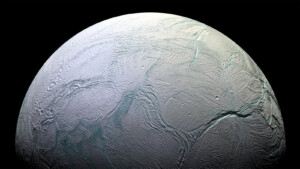
Wild and Wonderful Space Volcanoes!
Caitlin Ahrens, Ph.D.
Sunday, February 20, 2022
7:30 PM to 9:00 PM EST
Online event
Monthly Meeting – Public Invited
Abstract:
How are there many different types of volcanoes in our Solar System? How do these volcanoes form and evolve? We’ll explore the marvelous volcanic wonders of the Solar System by deep diving into how they behave and form from different planetary materials, including the mysteries of cryovolcanism!
Bio:
Caitlin Ahrens’ research involves remote sensing of icy surfaces and volatile interactions, including permanently shadowed craters at the lunar poles and cryovolcanism. Dr. Ahrens also works on several planetary geomorphology projects, including lava flow morphology, caldera formation, and rheology, on Mars, Ceres, Titan, and Pluto.
Dr. Ahrens received her B.S. in Physics/Astrophysics and Geology from West Virginia University in 2015, and a Ph.D. in Space and Planetary Science at the University of Arkansas in 2020. Dr. Ahrens is currently a NASA Postdoctoral Program Fellow at the Goddard Space Flight Center, and a member of the Diviner Science Team with the Lunar Reconnaissance Orbiter. In 2018, she was awarded the Ten Outstanding Young Americans award by the Jaycees for her efforts in science communication and outreach.
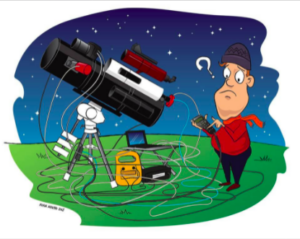
Improving the Performance of Your Imaging Mount
Eric Snow, Ph.D.
Sunday, March 13, 2022
7:30 PM to 9:00 PM EST
Online event
Monthly Meeting – Public Invited
Abstract:
In this presentation, Eric will share his experience on improving the performance of equatorial mounts, a critical and expensive component of astrophotography systems. He will start with the basics of operation and cover the common sources of tracking errors found in lower- to moderately-priced systems. Eric will then present a strategy to minimize these errors by using “hypertuning” and optimized guiding. The presentation will serve as a “How-To” guide for achieving atmospheric-seeing-limited imaging performance with less expensive mounts.
Bio:
Dr. Eric Snow recently retired from a 35-year scientific career at the Naval Research Laboratory where he served as the Director of the Institute for Nanoscience and as Head of the Physics of Electronic Materials Branch. Eric’s field of expertise is Nanoscience, which is the study and engineering of matter at the nanometer length scale. In retirement Eric has changed course and is learning about the universe at the opposite end of the length scale, the scale of light-years. In this pursuit Eric joined NOVAC and has taken up the hobby of astrophotography.
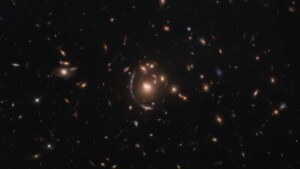
How to Measure Velocities of Distant Galaxy Clusters, and Why
Arthur Kosowsky, Ph.D.
Sunday, April 12, 2022
7:30 PM to 9:00 PM EST
Online event
Monthly Meeting – Public Invited
Abstract:
Galaxy clusters are the most massive gravitationally bound objects in the universe. Their hot ionized gas scatters photons of the cosmic microwave background, creating a microwave spectrum distortion (called the Thermal Sunyaev-Zeldovich Effect) which recent experiments have used to identify thousands of clusters. Velocities of these clusters with respect to the cosmic rest frame can be probed using a related hot-gas scattering effect (the Kinematic Sunyaev-Zeldovich Effect) or a subtle gravitational lensing effect (the transverse lensing effect). I will describe these effects and their detection prospects in upcoming cosmic microwave background experiments. Velocities of galaxy clusters reflect the growth of structure in the universe, and so provide one route to probing whether the accelerating expansion of the universe is due to some mysterious dark energy or to a modification of general relativity on cosmological scales.
Bio:
Arthur Kosowsky is Professor and Chair of Physics and Astronomy at the University of Pittsburgh. He received his Ph.D. from the University of Chicago in 1994 and spent three years as a Junior Fellow at Harvard University before taking a faculty job at Rutgers University. He moved to Pittsburgh in 2005. Major research interests have included the cosmic microwave background radiation, properties of the universe, and gravitational waves. Kosowsky was a founding member of the Atacama Cosmology Telescope collaboration and the Simons Observatory collaboration.
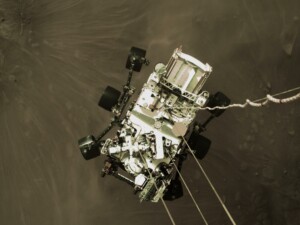
Mars 2020 Perseverance Rover: From Launch to Landing
Swati Mohan, Ph.D.
Sunday, May 15, 2022
7:30 PM to 9:00 PM EST
Online event
Monthly Meeting – Public Invited
Abstract:
The Mars 2020 mission was created to build off of the discoveries of its predecessors. The previous 4 rovers had found the building blocks for life on Mars. The Mars 2020 perseverance rover is the most advanced rover of the set, with each upgrade carefully designed to fit as much of the heritage Curiosity design as possible. Envisioned in 2012, launched in 2020, and landing on February 18, 2021 in the midst of a global pandemic, Perseverance made history as the 5th rover to land on Mars. Its express mission is to seek the signs of past life. Perseverance is the first leg of an ambitious program of Mars Sample Return. The samples collected by Perseverance could one day tell us whether there was past life on Mars. This talk will detail the scientific roadmap of the previous Mars rover missions, detail the evolution of landing technology, the augmentation of Perseverance to include Terrain Relative Navigation, and finally describe Perseverance’s journey from launch to landing.
Bio:
Dr. Swati Mohan joined NASA Jet Propulsion Laboratory first in 2004, after completing her B.S from Cornell University in Mechanical & Aerospace Engineering. After working as a systems engineer on Cassini during Saturn Orbit Insertion and Huygens Probe release, she returned to graduate school in 2005 to MIT. Dr. Mohan received her M.S. and Ph.D. in Aeronautics/Astronautics from the MIT Space Systems Laboratory. Since her return to JPL in 2010, Dr. Mohan has worked on multiple missions such as GRAIL and OCO-3. For the past 8 Years, she has been the Lead Guidance, Navigation and Controls Systems Engineer for Mars 2020 Perseverance rover, focusing on Cruise and EDL. In 2020, she transitioned to Mars 2020 Guidance, Navigation, and Controls Operations lead and mission commentator for the landing of the Perseverance rover on February 18, 202. She is currently the supervisor of the Guidance, Navigation, and Controls Systems Engineering group at NASA Jet Propulsion Laboratory and is working on the Mars Sample Retrieval Lander. Swati also co-founded and manages the Small Satellite Dynamics Test bed.
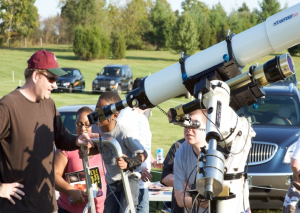
RSVP here.
Join NOVAC members who will be on hand to share views of the night sky.
Activities during Astronomy Day will include a telescope meet and greet, solar observing, a guided sky tour, night sky observing, and other demonstrations.
Feel free to walk around and enjoy the views of objects through a variety of telescopes on the field. Please ask the owner before using a telescope. If you have young children, please watch them around expensive astronomical equipment. Remember, telescope mirrors are sensitive to cigarette smoke and bug spray. Pets should also not be brought onto the observing field.
No astronomy experience or equipment is necessary to attend. If you have your own equipment, feel free to bring them along, even if it’s just a pair of binoculars.
For lighting, cover a flashlight in red cellophane (the darker the better). Bring along water to keep hydrated and plan on staying the entire evening or as long as the weather allows. Please dim your vehicles headlights when arriving and departing.
Crockett Park charges $7 per vehicle if you’re not a Fauquier County resident. However the event itself is completely free. NOVAC members are admitted free upon presentation of a membership card (available from the members-only section of the website). If you’re not a member but would like to become one, you can join the club online and print your membership card in only a few minutes.
Note: This event is weather-dependent and may be cancelled because of significant cloud cover or precipitation.
Head over to the Astronomy Day page for more information.
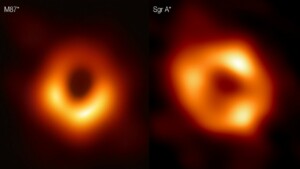
Public Monthly Meeting – Supermassive Black Holes at the Center of M87 and Milky Way: What We Learn
Razieh Emami, Ph.D.
Sunday, June 12, 2022
7:30 PM to 9:00 PM EST
Online event
Monthly Meeting – Public Invited
Abstract:
The most recent resolved images of Supermassive Black Holes (SMBHs) at the center of M87 (SMBH: M87*) as well as the Milky Way (SMBH: SgrA*) by the Event Horizon Telescope Collaboration (EHTC) has opened up a very promising era of precision (supermassive) Black Hole astrophysics. Thanks to the Event Horizon Telescope, we have now a horizon-resolved image of a few Supermassive Black Holes, as well as some knowledge about the structure of the magnetic field and the accretion flow around some BHs. Inspired by this discoveries, in this talk, Dr. Emami will speak about different aspects of the recently-reported (yet) un-polarized images of SgrA*. She will then continue with the polarized image of M87* and how we could use that to get some novel information about the structure of the magnetic field as well as the accretion flow around M87*. Dr. Emami will end with some of the next questions that scientists would like to address in the Event Horizon Telescope and the next generation of the Event Horizon Telescope (the NGEHT).
Bio:
Razieh Emami is a postdoc at the Center for Astrophysics. She has worked on a variety of different topics, including early universe cosmology, massive neutrinos, gravitational waves, TDES, galaxy evolution and BH physics. As a member of the Event Horizon Telescope (EHT) and its next generation (ngeht), she is currently focused on various topics relevant to the EHT, including black hole imaging, spectral analysis, model fitting and image reconstruction.
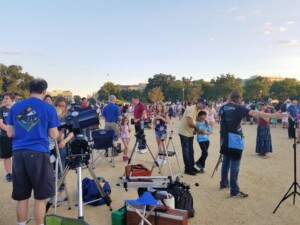
RSVP Here.
Members of the public are invited attend the largest annual astronomy outreach event in the U.S.
NOVAC will join 30 other astronomy/science organizations on the National Mall between 3rd and 4th Street to share astronomy concepts during the day and share views of the D.C. sky at night.
The festival is hosted by Hofstra University’s Department of Physics and Astronomy and their Astronomy Outreach Program.
The event will be on the National Mall between 3rd and 4th Street, sandwiched between the National Museum of the Native American and the National Gallery of Art- East Building.
Note: This outdoor event is weather-dependent and may be cancelled because of precipitation.
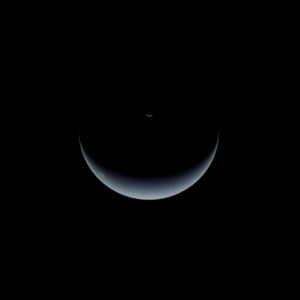
Planets Big and Small
Eve Lee, Ph.D.
Sunday, July 10, 2022
7:30 PM to 9:00 PM EST
Online event
Monthly Meeting – Public Invited
Abstract:
Planets in our solar system can be divided into rocky terrestrials as large as the Earth vs. gassy giants as small as Neptune. Planets outside of our solar system, on the other hand, look nothing like our own, with most of these detected exoplanets falling right in between the size of the Earth and Neptune. How can we understand such differences? I will describe the underlying physics that drives the huge diversity in the observed exoplanetary population and discuss how future missions can help us better understand the formation and evolution of solar and extrasolar planets.
Bio:
Dr. Eve Lee is an Assistant Professor of Physics at McGill University in Montreal, Canada. She received her Hon. BSc in Physics and Astronomy at the University of Toronto, PhD in Astrophysics at UC Berkeley, and spent two years as a Sherman Fairchild Postdoctoral Scholar at Caltech before taking up the faculty position at McGill in 2019. At McGill, Dr. Lee leads a theoretical astrophysics group specializing in the formation of stars and planets. She was recently awarded the 2022 Annie Jump Cannon Award from the AAS.
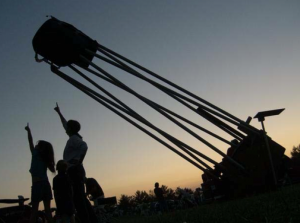
RSVP here.
Join NOVAC members who will be on hand to share views of the night sky.
Activities during Astronomy Day will include a telescope meet and greet, solar observing, a guided sky tour, night sky observing, and other demonstrations.
Feel free to walk around and enjoy the views of objects through a variety of telescopes on the field. Please ask the owner before using a telescope. If you have young children, please watch them around expensive astronomical equipment. Remember, telescope mirrors are sensitive to cigarette smoke and bug spray. Pets should also not be brought onto the observing field.
No astronomy experience or equipment is necessary to attend. If you have your own equipment, feel free to bring them along, even if it’s just a pair of binoculars.
For lighting, cover a flashlight in red cellophane (the darker the better). Bring along water to keep hydrated and plan on staying the entire evening or as long as the weather allows. Please dim your vehicles headlights when arriving and departing.
Crockett Park charges $7 per vehicle if you’re not a Fauquier County resident. However the event itself is completely free. NOVAC members are admitted free upon presentation of a membership card (available from the members-only section of the website). If you’re not a member but would like to become one, you can join the club online and print your membership card in only a few minutes.
Note: This event is weather dependent and may be cancelled due to overcast or precipitation.
For more information, see our Star Gaze page.
Learn about the formation of supermassive black holes and what exciting new discoveries await us from the James Webb Telescope. Join NOVAC and one of the leading astrophysists in this field of study, Dr. Jenny Greene, Professor of Astrophysical Sciences at Princeton University.
When: 10/9/22, 7:30pm EDT
Where: Dr. Greene will present virtually. Those interested may meet at George Mason University, Exploratory Hall, Room 3301 (arrive as early at 6:30pm).
For those wishing to join virtually here is the link:
NOVAC General Meeting
Sunday, October 9 · 7:30 – 9:00pm
Google Meet joining info
https://meet.google.com/osh-bcyd-gti
Or dial: (US) +1 484-430-1468 PIN: 486 839 001#
More phone numbers: https://tel.meet/osh-bcyd-gti?pin=1354183604637
Talk Title: The birth of supermassive black holes
Abstract: Supermassive black holes are ubiquitous at the centers of massive galaxies in the universe today, but we have no idea when or how these monsters are first formed. For the first time we have the chance to catch them as babies or adolescents just hundreds of millions of years after the Big Bang, thanks to the remarkable performance of the James Webb Space Telescope. I will discuss prospects for first results in this area in the coming year.
Jenny Greene is a Professor of Astrophysical Sciences at Princeton University, where she has been chasing intermediate-mass black holes for more than a decade. She is also the faculty director of the Prison Teaching Initiative.

